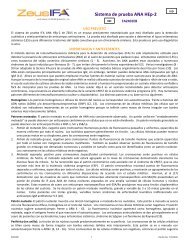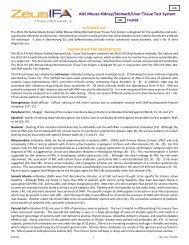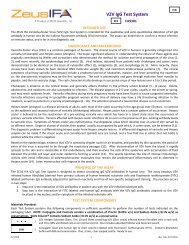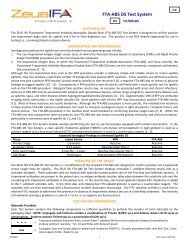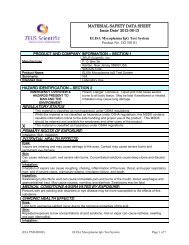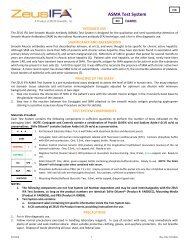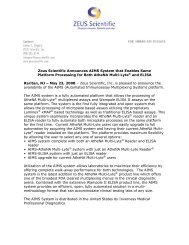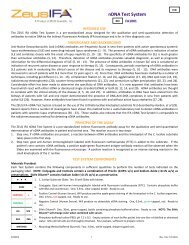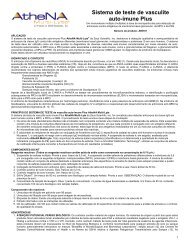B. burgdorferi IgG/IgM Test System - ZEUS Scientific
B. burgdorferi IgG/IgM Test System - ZEUS Scientific
B. burgdorferi IgG/IgM Test System - ZEUS Scientific
You also want an ePaper? Increase the reach of your titles
YUMPU automatically turns print PDFs into web optimized ePapers that Google loves.
TMB. <strong>burgdorferi</strong> <strong>IgG</strong>/<strong>IgM</strong> <strong>Test</strong> <strong>System</strong>FA9351GMINTENDED USEThe <strong>ZEUS</strong> IFA Borrelia <strong>burgdorferi</strong> <strong>IgG</strong>/<strong>IgM</strong> <strong>Test</strong> <strong>System</strong> is designed for the qualitative and semi-quantitative presumptive detectionof total (<strong>IgG</strong> and <strong>IgM</strong>) antibodies to Borrelia <strong>burgdorferi</strong> in human serum. This <strong>Test</strong> <strong>System</strong> should only be used for patients withsigns and symptoms that are consistent with Lyme disease. Equivocal or positive results must be supplemented by testing with astandardized Western blot procedure. Positive supplemental results are supportive evidence of exposure to B. <strong>burgdorferi</strong> and canbe used to support a clinical diagnosis of Lyme disease.SIGNIFICANCE AND BACKGROUNDB. <strong>burgdorferi</strong> is a spirochete that causes Lyme disease. The organism is transmitted by ticks of the genus Ixodes. In endemic areas,these ticks are commonly found on vegetation and animals such as deer, mice, dogs, horses, and birds. B. <strong>burgdorferi</strong> infectionshares features with other spirochetal infections (diseases caused by three genera in humans: Treponema, Borrelia, and Leptospira).Skin is the portal of entry for B. <strong>burgdorferi</strong> and the tick bite often causes a characteristic rash called erythema migrans (EM). EMdevelops around the tick bite in 60% to 80% of patients. Spirochetemia occurs early with wide spread dissemination through tissueand body fluids. Lyme disease occurs in stages, often with intervening latent periods and with different clinical manifestations.In Lyme disease there are generally three stages of disease, often with overlapping symptoms. Symptoms vary according to the sitesaffected by the infection such as joints, skin, central nervous system, heart, eye, bone, spleen, and kidney. Late disease is mostoften associated with arthritis or CNS syndromes. Asymptomatic subclinical infection is possible and infection may not becomeclinically evident until the later stages.Patients with early infection produce <strong>IgM</strong> antibodies during the first few weeks after onset of EM and produce <strong>IgG</strong> antibodies moreslowly (1). Although <strong>IgM</strong> only may be detected during the first month after onset of illness, the majority of patients develop <strong>IgG</strong>antibodies within one month. Both <strong>IgG</strong> and <strong>IgM</strong> antibodies can remain detectable for years. Isolation of B. <strong>burgdorferi</strong> from skinbiopsy, blood, and spinal fluid has been reported (2). However, these direct culture detection methods may not be practical in thelarge scale diagnosis of Lyme borreliosis. Serological testing methods for antibodies to B. <strong>burgdorferi</strong> include indirect fluorescentantibody (IFA) staining, immunoblotting, and enzyme immunoassay (EIA).B. <strong>burgdorferi</strong> is antigenically complex with strains that vary considerably. Early antibody responses often are to flagellin which hascross reactive components. Patients in early stages of infection may not produce detectable levels of antibody. Also, early antibiotictherapy after EM may diminish or abrogate good antibody response. Some patients may never generate detectable antibody levels.Thus, serological tests for antibodies to B. <strong>burgdorferi</strong> are known to have low sensitivity and specificity and because of suchinaccuracy, these tests cannot be relied upon for establishing a diagnosis of Lyme disease (3, 4).In 1994, the Second National Conference on Serological diagnosis of Lyme disease recommended a two-step testing system towardstandardizing laboratory serologic testing for B. <strong>burgdorferi</strong>. Because EIA and IFA methods were not sufficiently specific to supportclinical diagnosis, it was recommended that positive or equivocal results from a sensitive EIA or IFA (first step) should be furthertested, or supplemented, by using a standardized Western Blot method (second step) for detecting antibodies to B. <strong>burgdorferi</strong>(Western Blot assays for antibodies to B. <strong>burgdorferi</strong> are supplemental rather than confirmatory because their specificity is less thanoptimal, particularly for detecting <strong>IgM</strong>). Two-step positive results provide supportive evidence of exposure to B. <strong>burgdorferi</strong>, whichcould support a clinical diagnosis of Lyme disease but should not be used as a sole criterion for diagnosis.PRINCIPLE OF THE ASSAYThe <strong>ZEUS</strong> IFA B. <strong>burgdorferi</strong> <strong>IgG</strong>/<strong>IgM</strong> <strong>Test</strong> <strong>System</strong> is designed to detect circulating antibodies to the B. <strong>burgdorferi</strong> spirochete inhuman sera. The assay is particularly useful for, but not limited to, the diagnosis of Lyme disease in its later stages. The assayemploys B. <strong>burgdorferi</strong> immobilized on a glass slide and fluorescein-labeled anti-human immunoglobulin and involves two steps:1. Human sera are reacted with the spirochetes immobilized on the slides. Antibodies in the sera will bind to the spirochetes andremain attached after rinsing.2. Fluorescein-labeled anti-human immunoglobulin is added in the second step and will bind to the antibodies causing thespirochetes to fluoresce. The intensity of staining is graded on a scale of 1+ to 4+ or as negative. Negative sera lackingantibodies will not show fluorescence.TEST SYSTEM COMPONENTSMaterials Provided:Each <strong>Test</strong> <strong>System</strong> contains the following components in sufficient quantities to perform the number of tests indicated on thepackaging label. NOTE: Conjugate and Controls contain a combination of Proclin (0.05% v/v) and Sodium Azide (
20. Unopened/opened components are stable until the expiration date printed on the label, provided the recommended storageconditions are strictly followed. Do not use beyond the expiration date. Do not freeze.21. Evans Blue Counterstain is a potential carcinogen. If skin contact occurs, flush with water. Dispose of according to localregulations.22. Depending upon lab conditions, it may be necessary to place slides in a moist chamber during incubations.MATERIALS REQUIRED BUT NOT PROVIDED1. Small serological, Pasteur, capillary, or automatic pipettes.2. Disposable pipette tips.3. Small test tubes, 13 x 100mm or comparable.4. <strong>Test</strong> tube racks.5. Staining dish: A large staining dish with a small magnetic mixing set-up provides an ideal mechanism for washing Slides betweenincubation steps.6. Cover slips, 24 x 60mm, thickness No. 1.7. Distilled or deionized water.8. Properly equipped fluorescence microscope.9. 1 Liter Graduated Cylinder.10. Laboratory timer to monitor incubation steps.11. Disposal basin and disinfectant (i.e.: 10% household bleach – 0.5% Sodium Hypochlorite).The following filter systems, or their equivalent, have been found to be satisfactory for routine use with transmitted or incident lightdarkfield assemblies:Transmitted LightLight Source: Mercury Vapor 200W or 50WExcitation Filter Barrier Filter Red Suppression FilterKP490 K510 or K530 BG38BG12 K510 or K530 BG38FITC K520 BG38Light Source: Tungsten – Halogen 100WKP490 K510 or K530 BG38Incident LightLight Source: Mercury Vapor 200, 100, 50 WExcitation Filter Dichroic Mirror Barrier Filter Red Suppression FilterKP500 TK510 K510 or K530 BG38FITC TK510 K530 BG38Light Source: Tungsten – Halogen 50 and 100 WKP500 TK510 K510 or K530 BG38FITC TK510 K530 BG38SPECIMEN COLLECTION1. <strong>ZEUS</strong> <strong>Scientific</strong> recommends that the user carry out specimen collection in accordance with CLSI document M29: Protection ofLaboratory Workers from Occupationally Acquired Infectious Diseases. No known test method can offer complete assurancethat human blood samples will not transmit infection. Therefore, all blood derivatives should be considered potentiallyinfectious.2. Only freshly drawn and properly refrigerated sera obtained by approved aseptic venipuncture procedures with this assay (6, 7).No anticoagulants or preservatives should be added. Avoid using hemolyzed, lipemic, or bacterially contaminated sera.3. Store sample at room temperature for no longer than 8 hours. If testing is not performed within 8 hours, sera may be storedbetween 2 - 8°C, for no longer than 48 hours. If delay in testing is anticipated, store test sera at –20°C or lower. Avoid multiplefreeze/thaw cycles which may cause loss of antibody activity and give erroneous results.STORAGE CONDITIONSUnopened <strong>Test</strong> <strong>System</strong>.Mounting Media, Conjugate, SAVe Diluent ® , Slides, Positive and Negative Controls.Rehydrated PBS (Stable for 30 days).Phosphate-buffered-saline (PBS) Packets.R2260EN 3 (Rev. Date 7/8/2013)
ASSAY PROCEDURE1. Remove Slides from refrigerated storage and allow them to warm to room temperature (20 - 25°C). Tear open the protectiveenvelope and remove Slides. Do not apply pressure to flat sides of protective envelope.2. Identify each well with the appropriate patient sera and Controls. NOTE: The Controls are intended to be used undiluted.Prepare a 1:16 dilution (e.g.: 10µL of serum + 150µL of SAVe Diluent ® or PBS) of each patient serum. The SAVe Diluent ® willundergo a color change confirming that the specimen has been combined with the Diluent. Using two-fold dilutions, continueto dilute each patient serum to 1:256.Dilution Options:a. Users may titrate the Positive Control to endpoint to serve as a semi-quantitative (1+ Minimally Reactive) Control. In suchcases, the Control should be diluted two-fold in SAVe Diluent ® or PBS. When evaluated by <strong>ZEUS</strong> <strong>Scientific</strong>, an endpointdilution is established and printed on the Positive Control vial (± one dilution). It should be noted that due to variationswithin the laboratory (equipment, etc.), each laboratory should establish its own expected end-point titer for each lot ofPositive Control.b. When titrating patient specimens, initial and all subsequent dilutions should be prepared in SAVe Diluent ® or PBS only.3. Each patient serum should be screened using the 1:128 and 1:256 dilutions. With suitable dispenser (listed above), dispense20µL of each Control and each diluted patient in the appropriate wells.4. Incubate Slides at room temperature (20 - 25°C) for 30 minutes.5. Gently rinse Slides with PBS. Do not direct a stream of PBS into the test wells.6. Wash Slides for two, 5 minute intervals, changing PBS between washes.7. Rinse Slides for about 5 - 10 seconds in a gentle stream of distilled water as in step 5, and air dry. Slides must be completely drybefore adding Conjugate.8. Place 20µL of Conjugate on each well.9. Repeat steps 4 - 7.10. Place a small amount (4 - 5 drops) of Mounting Media between the two rows of offset wells and coverslip. Examine Slidesimmediately with an appropriate fluorescence microscope.NOTE: If delay in examining Slides is anticipated, seal coverslip with clear nail polish and store in refrigerator. It is recommendedthat Slides be examined on the same day as testing.QUALITY CONTROL1. Every time the assay is run, a Positive Control, a Negative Control and a Buffer Control must be included.2. It is recommended that one read the Positive and Negative Controls before evaluating test results. This will assist in establishingthe references required to interpret the test sample. If Controls do not appear as described, results are invalid.a. Negative Control - characterized by the absence of fluorescence.b. Positive Control - characterized by a 4+ to 3+ apple-green fluorescence staining of the B. <strong>burgdorferi</strong> organisms.3. Additional Controls may be tested according to guidelines or requirements of local, state, and/or federal regulations oraccrediting organizations.NOTES:a. The intensity of the observed fluorescence may vary with the microscope and filter system used.b. Non-specific reagent trapping may exist. It is important to adequately wash slides to eliminate false positive results.INTERPRETATION OF RESULTS1. Negative: No detectable antibody; result does not exclude B. <strong>burgdorferi</strong> infection. An additional sample should be testedwithin 4-6 weeks if an early infection is suspected (8). For the IFA test system, a negative reaction is equal to or less than 1+fluorescence of a 1:128 dilution.2. Positive: Antibody to B. <strong>burgdorferi</strong> presumptively detected. Per current recommendations, the result cannot be furtherinterpreted without supplemental Western-blot testing. (Western-blot assays for antibodies to B. <strong>burgdorferi</strong> are supplementalrather than confirmatory because their specificity is less than optimal, particularly for detecting <strong>IgM</strong>). Results should not bereported until the supplemental testing is complete. For the IFA test system, a positive reaction will demonstrate 1+ or greaterfluorescence staining at a dilution of 1:256 or greater.3. Borderline: Current recommendations state that borderline results should be followed by supplemental Western-blot testing.The borderline result should be reported with the results from Western-blot testing. Results should not be reported until thesupplemental testing is complete. For the IFA test system, a borderline specimen will demonstrate a 1+ or greater fluorescenceat 1:128 but less than 1+ fluorescence at 1:256.LIMITATIONS OF THE ASSAY1. Sera from patients with other spirochetal diseases (syphilis, yaws, pinta, leptospirosis, and relapsing fever), mononucleosis, andoccasionally systemic lupus erythematosus may give false positive results. In cases where false positive reactions are observed,extensive clinical, epidemiologic and laboratory workups should be carried out to determine the specific diagnosis. Falsepositive sera from syphilis patients can be distinguished from true Lyme disease positive patients by running an RPR or MHATPR2260EN 4 (Rev. Date 7/8/2013)
assay on such specimens (9). Lyme sera will be negative in these tests (9, 10). Also, when titered in the FTA-ABS test, syphilissera will show higher titers against the T. pallidum antigen than against the B. <strong>burgdorferi</strong> antigen (9).2. Patients with early Lyme disease may have undetectable antibody titers with this assay. In early Lyme disease <strong>IgG</strong>/<strong>IgM</strong>antibodies may not reach a level of diagnostic significance and may never do so when ECM is the sole manifestation (11). IfLyme disease is suspected early on, additional serum samples at varying intervals should be taken to demonstrate a rise in <strong>IgG</strong>titer.3. An alternative method for determining <strong>IgM</strong> antibodies may be more useful for diagnosing early Lyme disease or reinfection.4. Early antibiotic therapy may abort an antibody response to the spirochete.5. All data should be interpreted in conjunction with clinical symptoms of disease, epidemiologic data, and exposure in endemicareas.6. Screening of the general population should not be performed. The positive predictive value depends on the pretest likelihoodof infection. <strong>Test</strong>ing should only be performed when clinical symptoms are present or exposure is suspected.7. The performance characteristics of the <strong>ZEUS</strong> IFA B. <strong>burgdorferi</strong> <strong>IgG</strong>/<strong>IgM</strong> <strong>Test</strong> <strong>System</strong> are not established with samples fromindividuals vaccinated with B. <strong>burgdorferi</strong> antigens.EXPECTED RESULTSMost investigators agree that a cut-off dilution of 1:256 differentiates positive and negative results with a high degree of specificity,particularly in the later stages of Lyme disease (12). The 1:256 cut-off dilution was established in a study of 267 serum specimens.Of the 267 specimens, 177 were obtained from blood bank donors and 90 from non-Lyme disease patients (12 dermatologic, 2cardiac, 26 neurologic, and 50 patients with rheumatic diseases). One of the normal serum samples showed a titer >1:256, while 9produced titers >1:256 for a total of 10 out of 177 specimens. One out of 90 specimens obtained from subjects with non-Lymedisease disorders was >1:256; therefore, of the 267 sera tested, 1:256.PERFORMANCE CHARACTERISTICS1. The <strong>ZEUS</strong> IFA B. <strong>burgdorferi</strong> <strong>IgG</strong>/<strong>IgM</strong> <strong>Test</strong> <strong>System</strong> was compared to an ELISA assay in a double blind study at a large referencelaboratory. The results of this study are summarized in Table 1. The relative sensitivity and specificity of the IFA and ELISAassays in this study are based on specific diagnosis determined by clinical features and extensive laboratory workups of patientsin each disease category, i.e., all suspected Lyme disease patients demonstrated specific clinical features that were confirmed bypositive assays for Lyme disease antibodies.Table 1: Comparison of the <strong>ZEUS</strong> IFA B. <strong>burgdorferi</strong> <strong>IgG</strong>/<strong>IgM</strong> <strong>Test</strong> <strong>System</strong> and a reference ELISA AssayDisease Category Number <strong>Test</strong>ed IFA Positive ELISA PositiveB. <strong>burgdorferi</strong> ECMNeurologicArthritic1091018106910Autoimmune 112 5 2Other Infectious Disease 106 23 16The overall sensitivity for both methods was:*The overall specificity for each method was:**As compared to clinical diagnosis and other clinical laboratory data.2. These results show that the <strong>ZEUS</strong> IFA B. <strong>burgdorferi</strong> <strong>IgG</strong>/<strong>IgM</strong> <strong>Test</strong> <strong>System</strong> procedure is less sensitive in the early stages of Lymedisease (B. <strong>burgdorferi</strong>), particularly in those cases associated with erythema chronicum migrans. However, in complicatedcases of Lyme disease, the sensitivity was virtually 100% for both methods. These results are consistent with the lower amountof specific <strong>IgG</strong> antibodies present in the early stages of Lyme disease. These results are consistent with routine referralspecimens submitted for analysis at the reference laboratory. The study was conducted in a double-blind manner. The resultsof this study are shown in Table 2.Table 2: Comparison of the <strong>ZEUS</strong> IFA B. <strong>burgdorferi</strong> <strong>IgG</strong>/<strong>IgM</strong> <strong>Test</strong> <strong>System</strong> and a reference IFA ProcedureNumber Number Negative Number Positive<strong>Test</strong>ed <strong>ZEUS</strong> IFA Reference IFA <strong>ZEUS</strong> IFA Reference IFA50 38 38 12 12The results of this study show 100% agreement between the two procedures in detecting positive and negative sera using a 1:256dilution as a cut-off point.3. In a study conducted by the CDC (10), the IFA and ELISA methods for detecting antibodies in serum against B. <strong>burgdorferi</strong> werecompared employing serum specimens obtained during different stages of Lyme disease. The results are shown in Table 3.Table 3:Disease Stage IFA Positive ELISA PositiveECM 50 50Carditis 100 100Neuritis 92 100Arthritis 100 97More than one complication 71 8066%87%79%92%R2260EN 5 (Rev. Date 7/8/2013)
These results are similar to those reported in Table 1 above and further substantiates that the IFA assay for detection of antibodiesassociated with Lyme disease is a reliable, sensitive method, particularly in cases of complicated late stage Lyme disease.4. The following information is from a serum panel obtained from the CDC and tested in-house at <strong>ZEUS</strong> <strong>Scientific</strong>, on the <strong>ZEUS</strong> IFAB. <strong>burgdorferi</strong> <strong>IgG</strong>/<strong>IgM</strong> <strong>Test</strong> <strong>System</strong>. The results are presented as a means to convey further information on the performance ofthis assay with a masked characterized serum panel. This does not imply an endorsement of the assay by CDC. Table 4 showsthe results of this study.Table 4: The CDC B. <strong>burgdorferi</strong> Disease Serum Panel Stratified by Time After OnsetTime from Onset Positive +/- Negative Total% Agreement withClinical DiagnosisNormals 2 1 1 4 33%< 1 month 5 0 1 6 83%1-2 months 7 0 2 9 78%3-12 months 13 2 4 19 76%> 1 year 1 4 3 8 25%Total 28 7 11 46 69%REFERENCES1. Steere AC, et al: J. Infect. Dis. 154:295-300, 1986.2. Rosenfeld MEA:Serodiagnosis of Lyme disease. J. Clin. Microbiol. 31:3090-3095, 1993.3. Steere AC, Taylor E, Wilson ML, Levine JF, and Spielman A: Longitudinal assessment of the clinical and epidemiologic features of Lyme disease in a definedpopulation. J. Infect. Dis. 154:295-300, 1986.4. Bakken LL, Callister SM, Wand PJ, and Schell RF:Interlaboratory Comparison of <strong>Test</strong> Results for Detection of Lyme Disease by 516 Patients in the Wisconsin StateLaboratory of Hygiene/College of American Pathologists Proficiency <strong>Test</strong>ing Program. J. Clin. Microbiol. 35:537-543, 1997.5. U.S. Department of Labor, Occupational Safety and Health Administration: Occupational Exposure to Bloodborne Pathogens. Final Rule. Fed. Register 56:64175-64182, 1991.6. Procedures for the collection of diagnostic blood specimens by venipuncture - Second edition: Approved Standard (1984). Published by National Committee forClinical Laboratory Standards.7. Procedures for the Handling and Processing of Blood Specimens. NCCLS Document H18-A, Vol. 10, No. 12, Approved Guidelines, 1990.8. Barbour A:Laboratory Aspects of Lyme Borreliosis. Clin Micr. Rev. 1:399-414, 1988.9. Hunter EF, Russell H, Farshy CE, et al: Evaluation of sera from patients with Lyme disease in the fluorescent treponemal antibody-absorption test for syphilis.Sex. Trans. Dis. 13:236, 1986.10. Russel H, Sampson JS, Schmid GP, Wilkinson HW, and Plikaytis B: Enzyme-linked immunosorbent assay and indirect immunofluorescence assay for Lyme disease.J. Infect. Dis. 149:465, 1984.<strong>ZEUS</strong> <strong>Scientific</strong>, Inc.200 Evans Way, Branchburg, New Jersey, 08876, USAToll Free (U.S.): 1-800-286-2111International: +1 908-526-3744Fax: +1 908-526-2058<strong>ZEUS</strong> IFA and SAVe Diluent ® are trademarks of <strong>ZEUS</strong> <strong>Scientific</strong>, Inc.Customer Service E-mail: orders@zeusscientific.comTechnical Support E-mail: support@zeusscientific.comWebsite: www.zeusscientific.com© 2013 <strong>ZEUS</strong> <strong>Scientific</strong>, Inc. All Rights Reserved.R2260EN 6 (Rev. Date 7/8/2013)



